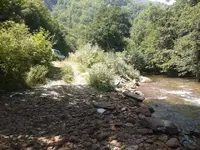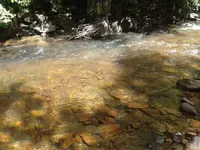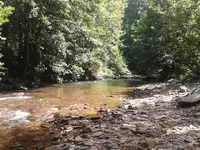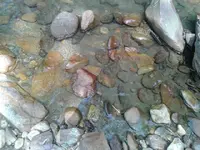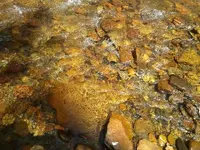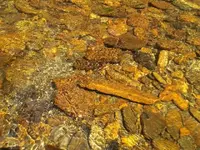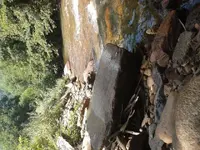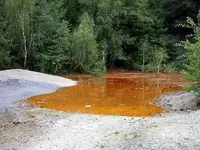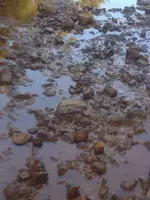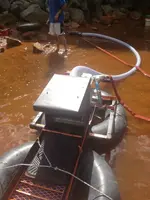Truffles EOD,
Very interesting thread filled with adventure and possible danger. The water color bothers me of course I'm used to the crystal clear mountain waters of Northern California that I've drunk now for 50 years with no ill affects. The color bothers me as when you start to prospect you will be needing drinking water so I suggest you ask a few more questions of the locals to see if they drink it every day all their lives or Only when they are sick! IF you must plan on drinking the water I would also suggest having it tested for potential dangers as mankind has poisoned quite a few things. I would also check into various types of water filters to see if some sort of activated charcoal types might remove some of the dissolved minerals.
Next: Panning is a very simple operation though it does take a "learned technique" to do properly. There are several panning How To videos on You Tube and I would recommend your watching them. Also I suggest you obtain some lead birdshot, shotgun pellets, to use as a test particle in your gold pan. If you can pan out a half pan of sample dirt, this means it would be nice to Classify your raw sample (run the raw sample through a 1/4" mesh screen) and still have all the lead pellets in it then you are doing a good job panning. The birdshot is a visible indicator that you are keeping all the 'heavies' in the pan and therefore would be retaining any free gold that might be out there, gold and any other heavies.
In addition it might be helpful to have a mining magnet with you to help sort out the magnetic particles so it is easier to pan your sample. I suggest obtaining a 35 mm film can with lid and placing some strong magnets into the can and putting the lid tightly back on. The magnets will be in the bottom of the can, touch the outer bottom of the can to your sample, if there are any magnetic particles on the surface of the raw sample they will now be on the bottom of the can. Hold the can over some sort of catching container, this includes a plastic bag, shake the can up and down as this will cause the magnets to become airborne inside the can thus releasing the magnetic particles into the catch container. This sort of gathering can be of greatest usefulness once the halt pan of concentrate, screened material, has been worked down to fines as then the "black sands" will be at their greatest in your pan. Removing the magnetic black sands with the magnet will reduce the labor required to pan them out of the pan and make it easier and faster to find out what is in the pan underneath the black sands. Note: IF there is any fine free gold or other valuable mineral it might get caught up in the magnetic material attached to the 35 mm film can that is now in your catch container. It is worthwhile to go through these magnetic black sands "at home" to help confirm what Might be in them.
These items will get you started on the right track. Knowing the local mineral laws and possibly property lines will help to keep you safe. There also could be a few animals or small pests like ticks to learn about in the area. I carry a small aspirin bottle filled with Cayenne Pepper as a protective device just in case something or someone needs to be stopped from harming me. I figure throwing this stuff into their face should stop them for a significant amount of time to allow me to be safe from them.
Detectors: Your choices over there are likely limited. Clay has given you excellent inputs on the ground as well as detectors including the Minelab products. I myself use a Whites GMT, possibly not available there, and it finds gold for about $800 U.S. BUT do not rush out and purchase a detector! FIRST do your panning research as it will tell you if there is anything there THEN if there is enough of any free metallic mineral you want to locate, then and only then consider the purchase of a detector. Detecting things like gold is one of the toughest things to locate with a detector BUT once you've found gold/silver/platinum with a detector you will be hooked. If there was some fee mineral the first item I would purchase would be a sluice box. If the sluice box work showed good results then and only then would I purchase a metal detector.
I combine the use of my GMT with my sluice box as follows: I locate a placer deposit, in my case of gold, by panning or possibly right off with the detector IF the detector can be swung in the area. Again Clay has given you good info by suggesting a Small coil!!!!! Boulders and bushes keep a person from easily swinging a detector coil so panning again could be the only way to test an area for gold. So, I find a mineral deposit on the down stream side of a large obstruction to the flow of water like a large boulder but there are so many other boulders there that I can not swing my detector with its smallest coil easily. So, I fill a bucket with dirt and rocks. I locate or make a spot on a gravel bar where there is no signal to my search coil. I dump my bucket of raw sample onto this no signal spot. I then swing my detector coil over the sample (the detector is turned on) and if I do not get a signal from the detector that some gold is in the sample I do not work that pile of dirt. If I get a signal then I work the dirt via the sluice and pull out the gold. Note here: The GMT will locate some really small gold particles and this is what you want from ANY detector as if it will find really small gold then it will find larger gold as well. Note here: When I am out detecting I always carry a "Sample Target" with me, this is a small piece of lead or gold that I know my detector will find attached to an easy to see colored plastic 'thing' like a poker chip. The target metal can be glued or simply taped to the plastic poker chip and the size of the poker chip makes it easy to handle and to see when tossed onto the ground.
Ok, this should see you through your initial learning of how to use the gold pan kit you've ordered and will get you out into the field with a small digging tool along with a simple pry bar, some food, some sun protection (large brimmed hat), insect repellent and a small pack to carry all of it in. You should also have some boots that give you some good ankle support/protection as you do not want to twist or break a leg out there.
Be safe, have fun and the best of success to you on your adventure.............................63bkpkr
View attachment 846534 Gold found while panning, detecting & panning and detecting & sluicing in order of first to last find.
View attachment 846537 Gold, lead bullets, magnetic rocks found while panning
View attachment 846538 Using the GMT to test classified sample (mesh wastebasket used to sort out larger rocks) for signs of gold being in the sample before putting any more work into the sample.
View attachment 846541 Folding shovel in home made 1/4" mesh "classifying" unit. Classifying a raw sample does not take sophisticated equipment. A wire mesh kitchen tool works, a wire food basket works, perforated metal 'things' work or you can make your own out of any wire mesh just cover the ends of the cut wire with duct tape so you are not always poking or cutting yourself.
